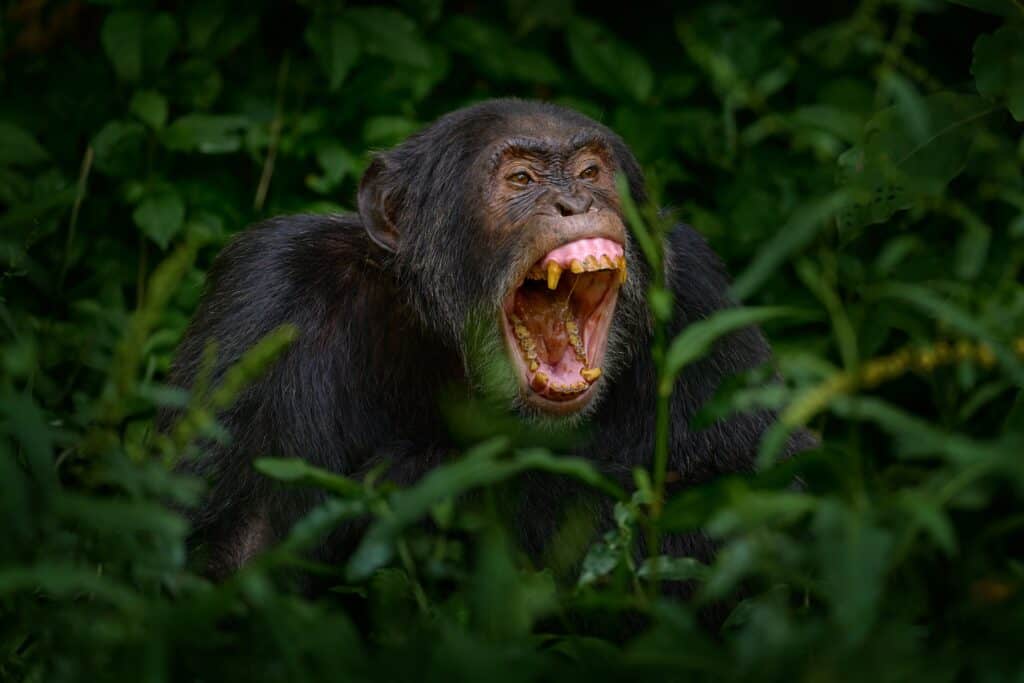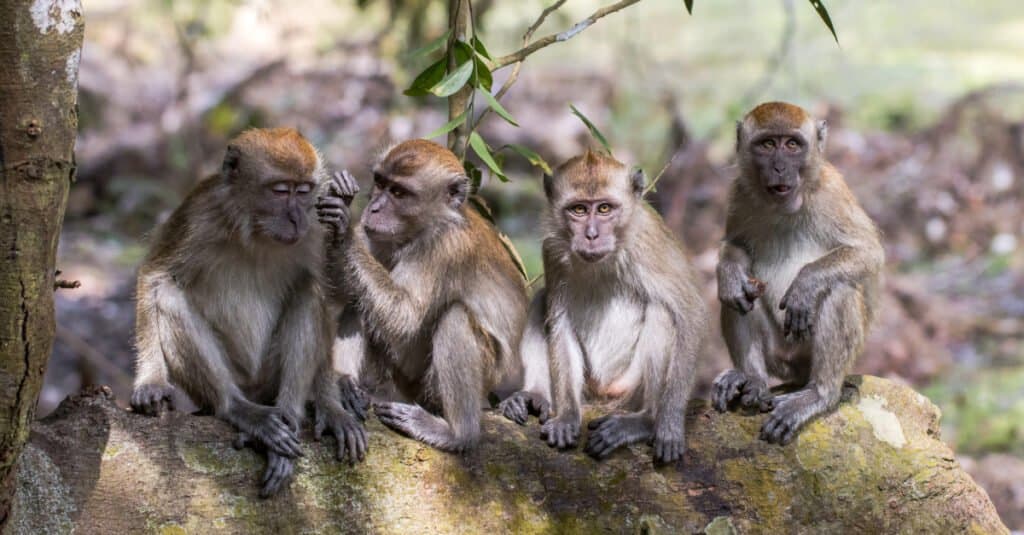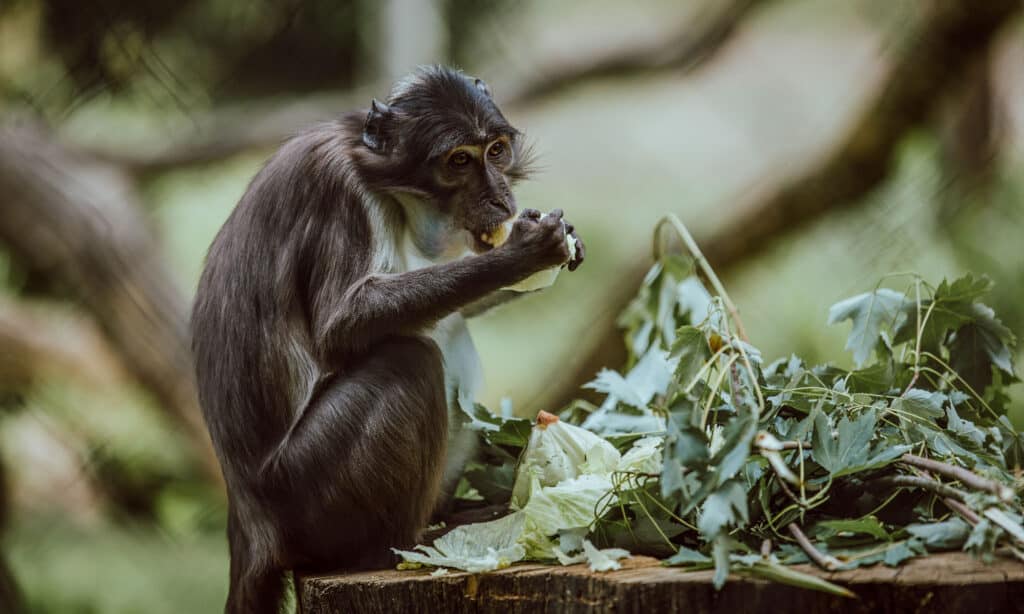The term ‘monkey’ is often used informally to refer to apes, chimpanzees, gibbons, and gorillas as well as true monkeys. All of these animals are primates – a diverse group of animals that includes over 200 species. Primates have several things in common including a large brain, hands adapted for grasping, and complex social groups. Living in groups offers a lot of advantages including protection and food availability. However, it comes with its complications which include disagreements between group members. Some disagreements end in fights! Here we explain the six main fascinating reasons why monkeys fight each other.
1. Some Species Are Just More Aggressive

Chimpanzees can be more aggressive than some other primates.
©Ondrej Prosicky/Shutterstock.com
Whilst some primate species, such as the western lowland gorillas, can be described as gentle giants, the same cannot be said for chimpanzees. Aggression and violence are inherent to a chimpanzee’s nature. Male chimpanzees are often seen attacking one another over territorial disputes. These violent disputes can even go so far as to end in murder.
2. Other Monkeys Are Fighting

Fights can spread through a group of monkeys.
©Ken Griffiths/Shutterstock.com
Some monkey conflicts spread like a disease. It’s almost as if they are contagious. Scientists from Cornell University and the Santa Fe Institute studied captive pigtailed macaques at the Yerkes National Primate Center in Georgia. They found that there were frequent conflicts but these were interspersed by periods where no fighting occurred. When one fight started, it would soon spread throughout the group. None of the macaques would stop fighting until the original conflict had been resolved. There seemed to be some form of collective decision-making at play here.
3. Competition for Resources

Competition over food can end in fights.
©ShutterSparrow/Shutterstock.com
There are only so many resources to go around. In the wild, species are always competing to get food, water, and shelter. The strongest and most dominant individuals win the race for resources and therefore are most likely to reproduce. This means that the next generation is produced by the strongest individuals and the future of the species is assured.
Monkeys fight off rival troops in competition over food, water, and sleeping sites. Within the group, there can also be battles over food, status, and mating rights.
4. Changing Habitats

Loss of habitat may be increasing monkey fights.
©Cheryl Zion/Shutterstock.com
Some primate species that used to get along finely have started to fight with each other. In particular, this has been noted in the relationship between chimpanzees and gorillas in the tropical jungles of Africa. These two species inhabit similar areas and feed on similar items including plants, fruits, and insects. Observations in the Loango National Park in Gabon have revealed that chimpanzees have started to attack infant gorillas. The reason for this behavior change is not entirely understood, but experts suspect that it is related to competition over limited resources. This may be associated with habitat loss.
5. Sexual politics

Sexual politics can play a role in monkey fights.
©Amanda Coetzee/iStock via Getty Images
The sexual politics within groups of primates can be confusing! This is often because males and females have different agendas. Females fight to obtain resources such as food, water, and shelter so that they can successfully raise their offspring. Males fight because they want to defend their mating rights with the females.
Intergroup fighting is when one group of primates fights with another. If you are a monkey, this is a good thing if it gets you more resources and more people to mate with. It is a bad thing if you end up getting badly injured or even killed in the fight! Some research has indicated that females use social incentives to increase male participation in fights. Conversely, male monkeys can use punishment and coercion to de-escalate fights.
6. Picking on Sick Monkeys

Sick monkeys are more likely to get attacked.
©iStock.com/DejaVu Designs
Monkeys can get infections in the same way as we do. These infections are often accompanied by a fever and when monkeys get sick, they often lose their appetite and spend more time resting. However, life is hard in the wild. If a monkey cannot keep up with the rest of the troop, they become vulnerable to attack by predators such as cheetahs and jackals.
But that’s just the start of the sick monkey’s problems! Research has shown that feverish monkeys are twice as likely to be attacked by one of their group mates than a fit monkey. Just when a sick animal is least able to fight back, they are most likely to be attacked! This can cause the already sick monkey to be injured. If they hold a dominant status within the troop, they are probably going to have to relinquish it.
Summing up Why Monkeys Fight Each Other
Monkeys fight within their group and with other groups over competition for resources including mating partners and food. Fights can also break out because some species are naturally aggressive and confrontation can spread amongst groups of monkeys in a form of collective decision making. Complex relations between males and females can cause some fights and sick monkeys are more likely to be attacked than well individuals.
The photo featured at the top of this post is © Sompao/Shutterstock.com
Thank you for reading! Have some feedback for us? Contact the AZ Animals editorial team.







